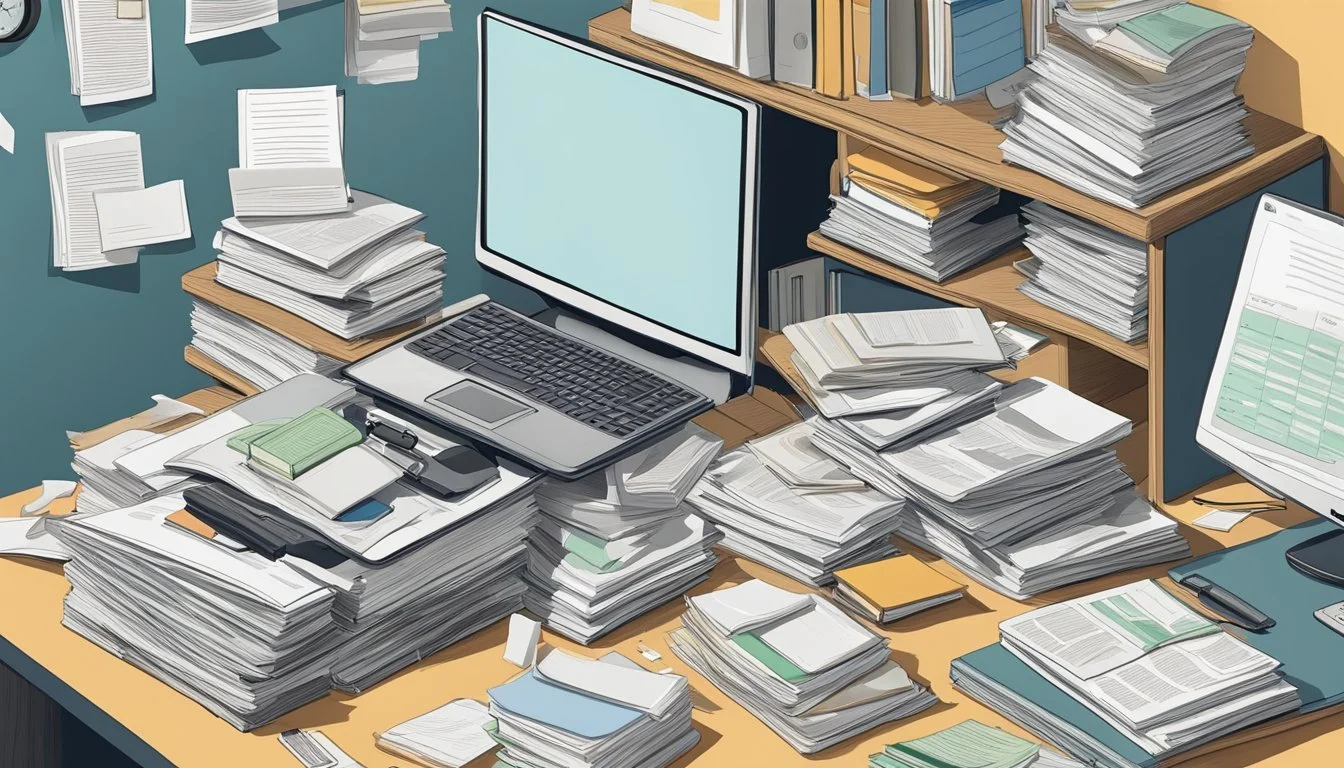Essential Hoarding Disorder Resources: Finding Help and Support for Recovery
Hoarding disorder affects millions of people worldwide, causing significant distress and impairment in daily life. Recognizing the need for support, numerous resources have emerged to assist those struggling with this condition. From professional therapies to community support groups, a range of options exists to help individuals and their families navigate the challenges of hoarding.
For those seeking help with hoarding disorder, a variety of resources are available, including therapists specializing in hoarding behavior, cleanup services, and local task forces dedicated to addressing the issue. These resources aim to provide comprehensive support, addressing both the psychological aspects of hoarding and the practical challenges of decluttering and organizing living spaces.
The International Hoarding Alliance serves as a central hub, connecting individuals and families with experts in the field. This organization, along with others like the National Alliance on Mental Illness (NAMI), offers valuable information on treatment options, support groups, and educational materials. By utilizing these resources, those affected by hoarding disorder can take important steps towards recovery and improved quality of life.
Understanding Hoarding Disorder
Hoarding disorder is a complex mental health condition characterized by difficulty discarding possessions and excessive acquisition of items. It can significantly impact a person's quality of life and relationships.
Definition and Symptoms
Hoarding disorder involves persistent difficulty parting with possessions, regardless of their actual value. Individuals experience distress at the thought of discarding items and feel a strong need to save them. This leads to the accumulation of clutter that congests living spaces and impairs their use.
Common symptoms include:
Inability to throw away possessions
Severe anxiety when attempting to discard items
Excessive acquisition of unnecessary objects
Cluttered living spaces that prevent normal use of rooms
Difficulty organizing possessions
Indecisiveness about what to keep or discard
Social isolation due to embarrassment about living conditions
Causes and Risk Factors
The exact causes of hoarding disorder are not fully understood, but several factors may contribute to its development:
Genetic predisposition: Studies suggest a hereditary component, with hoarding tendencies often running in families.
Brain differences: Neuroimaging studies have shown altered activity in brain regions associated with decision-making and emotional attachment in individuals with hoarding disorder.
Traumatic experiences: Significant life events or losses may trigger hoarding behaviors as a coping mechanism.
Certain personality traits: Perfectionism, indecisiveness, and difficulty processing information may increase the risk of hoarding.
Co-occurring mental health conditions: Depression, anxiety disorders, and attention-deficit/hyperactivity disorder (ADHD) often co-exist with hoarding disorder.
Prevalence and Statistics
Hoarding disorder affects an estimated 2-6% of the general population. It typically begins in adolescence or early adulthood and tends to worsen with age. The condition is equally common among men and women.
Key statistics:
Average age of onset: 13-15 years
75% of individuals with hoarding disorder have a co-occurring mental health condition
50% of people with hoarding disorder also experience depression
Hoarding behaviors are more prevalent in older adults, with up to 6% of those over 55 affected
Hoarding disorder often goes undiagnosed or untreated due to shame, lack of awareness, or reluctance to seek help. Early intervention and proper treatment can significantly improve outcomes and quality of life for those affected.
Diagnosis and Assessment
Diagnosing and assessing hoarding disorder requires a comprehensive approach involving professional evaluation, specific diagnostic criteria, and specialized assessment tools. These methods help clinicians accurately identify the condition and determine its severity.
Professional Evaluation
Mental health professionals play a crucial role in diagnosing hoarding disorder. Psychiatrists, psychologists, and clinical social workers with expertise in this area conduct thorough evaluations. They gather information through clinical interviews, observing the living environment, and speaking with family members when possible.
The evaluation process typically includes:
Detailed history of acquiring and discarding behaviors
Assessment of clutter levels in the home
Exploration of the emotional attachments to possessions
Evaluation of insight into the hoarding behaviors
Screening for co-occurring mental health conditions
Diagnostic Criteria
The Diagnostic and Statistical Manual of Mental Disorders, Fifth Edition (DSM-5) outlines specific criteria for diagnosing hoarding disorder:
Persistent difficulty discarding possessions, regardless of value
Perceived need to save items and distress associated with discarding them
Accumulation of possessions that clutter living areas, compromising their use
Significant distress or impairment in social, occupational, or other important areas of functioning
Hoarding not attributable to another medical condition or mental disorder
These criteria help differentiate hoarding disorder from normal collecting behaviors or other mental health conditions.
Assessment Tools
Several validated assessment tools aid in diagnosing and measuring the severity of hoarding disorder:
Saving Inventory-Revised (SI-R): A 23-item questionnaire assessing difficulty discarding, excessive acquisition, and clutter.
Clutter Image Rating (CIR): A pictorial assessment of clutter levels in different rooms.
Hoarding Rating Scale (HRS): A brief interview measuring key hoarding symptoms.
Activities of Daily Living in Hoarding (ADL-H): Evaluates the impact of hoarding on daily functioning.
These tools provide objective measures to complement clinical judgment and help track progress during treatment.
Treatment Options
Several effective approaches can help individuals manage hoarding disorder. These include specialized therapy, medication in some cases, peer support, and professional organizing assistance.
Cognitive Behavioral Therapy
Cognitive Behavioral Therapy (CBT) is the primary treatment for hoarding disorder. This skills-based approach helps individuals identify and change unhelpful thoughts and behaviors related to acquiring and discarding items.
CBT for hoarding typically involves:
Challenging beliefs about possessions
Practicing decision-making skills
Exposure exercises to reduce anxiety about discarding
Developing organizational strategies
Therapists may conduct sessions in the client's home to address specific challenges. CBT can be conducted individually or in group settings, usually lasting several months.
Medication
While no medications are specifically approved for hoarding disorder, some may help manage associated symptoms or co-occurring conditions.
Medications sometimes prescribed include:
Anti-anxiety medications
Stimulants for attention difficulties
Medication is typically used in conjunction with therapy rather than as a standalone treatment. A psychiatrist can assess whether medication might be beneficial based on individual symptoms and needs.
Support Groups
Support groups offer a valuable resource for individuals with hoarding disorder. These groups provide:
Peer support and understanding
Shared experiences and coping strategies
Motivation and accountability
Resources and information
Groups may be led by mental health professionals or peers. Both in-person and online options are available in many areas. Regular attendance can complement individual therapy and help maintain progress.
Professional Organizers
Professional organizers with expertise in hoarding disorder can provide practical assistance in decluttering and organizing living spaces. Their services often include:
Creating customized organizational systems
Assisting with decision-making about items
Teaching sorting and decluttering skills
Developing maintenance strategies
Working with a professional organizer can make the decluttering process less overwhelming. They often collaborate with therapists to ensure a supportive approach aligned with treatment goals.
Support for Loved Ones
Supporting a family member or friend with hoarding disorder can be challenging. Effective communication, setting healthy boundaries, and finding proper support are crucial for both the individual with hoarding disorder and their loved ones.
Communicating Effectively
Open, honest, and non-judgmental communication is key when supporting someone with hoarding disorder. Use "I" statements to express concerns and feelings. For example, say "I'm worried about your safety" rather than "You're living in a dangerous mess."
Listen actively and empathetically to understand their perspective. Avoid criticizing or arguing about their possessions. Instead, focus on expressing care and offering help.
Ask open-ended questions to encourage dialogue. "How do you feel about the amount of stuff in your home?" can be more productive than "Don't you think you have too much junk?"
Setting Boundaries
Establish clear, consistent boundaries to protect your own well-being while supporting your loved one. Decide what level of involvement you're comfortable with and communicate this clearly.
Set limits on financial assistance, such as not paying for storage units. Give advance notice of changes: "I can't continue paying for the storage unit after three months."
Respect your loved one's autonomy. Avoid throwing away items without permission, as this can damage trust and hinder progress.
Create a safe, clutter-free space in your own home if your loved one visits. This models healthy living environments without directly criticizing their habits.
Finding Support
Seek support for yourself to manage stress and prevent burnout. Join support groups for families of individuals with hoarding disorder. These provide a space to share experiences and coping strategies.
Educate yourself about hoarding disorder through reputable sources. This knowledge can help you understand your loved one's challenges and respond more effectively.
Consider family therapy or counseling to improve communication and develop strategies for supporting your loved one. A therapist experienced in hoarding disorder can guide family interventions.
Connect with local resources such as mental health professionals, professional organizers, and social workers who specialize in hoarding disorder. They can provide valuable guidance and support for both you and your loved one.
Prevention and Maintenance
Preventing hoarding behaviors and maintaining progress are crucial aspects of managing hoarding disorder. Effective strategies can help individuals avoid relapse and build healthier habits.
Preventive Strategies
Early intervention is key in preventing hoarding behaviors from escalating. Recognizing warning signs, such as difficulty discarding items or excessive acquisition, can prompt timely action. Developing organizational skills and establishing clear sorting systems help manage possessions effectively.
Regular decluttering routines prevent accumulation. Setting aside specific times for organizing and discarding items creates a structured approach. Implementing a "one in, one out" rule helps maintain balance in possessions.
Education about hoarding disorder raises awareness and promotes early recognition. Family members and friends can learn to identify potential signs and offer support.
Coping Mechanisms
Cognitive restructuring techniques help challenge and modify unhelpful thoughts related to possessions. Individuals can practice questioning the perceived value of items before acquiring or keeping them.
Stress management strategies, such as mindfulness and relaxation exercises, reduce anxiety associated with discarding. These techniques help individuals cope with emotional attachments to objects.
Gradual exposure to discarding items builds confidence and reduces anxiety over time. Starting with less emotionally charged objects and progressing slowly helps overcome resistance.
Alternative coping methods, like journaling or creative activities, provide healthier outlets for emotional expression.
Ongoing Support and Follow-Up
Regular therapy sessions help maintain progress and address new challenges. Cognitive Behavioral Therapy (CBT) continues to be effective in long-term management.
Support groups offer a sense of community and shared experiences. Connecting with others facing similar challenges provides encouragement and practical advice.
Periodic home visits by mental health professionals or organizers help monitor progress and identify potential setbacks. These visits ensure adherence to maintenance strategies.
Establishing a support network of friends, family, or professionals provides accountability and assistance when needed. This network can offer reminders, encouragement, and practical help in maintaining an organized living space.
Legal and Ethical Considerations
Hoarding disorder intersects with legal and ethical concerns that affect individuals, communities, and healthcare providers. Rights must be balanced with responsibilities, while interventions require careful ethical consideration.
Rights and Responsibilities
Individuals with hoarding disorder have legal protections under the Americans with Disabilities Act (ADA). This includes the right to fair treatment and reasonable accommodations. Privacy rights are also important, though they may be limited if public safety is at risk.
Communities have responsibilities to address hoarding situations that pose health or safety hazards. Local ordinances often govern property maintenance and clutter levels. Code enforcement officials may intervene in severe cases.
Landlords face challenges balancing tenant rights with property maintenance obligations. Eviction may be pursued as a last resort if lease terms are violated and reasonable accommodations have failed.
Ethical Interventions
Mental health professionals must navigate complex ethical terrain when treating hoarding disorder. Informed consent is crucial, as is respecting client autonomy in decision-making about possessions.
Involuntary interventions should be considered only in cases of imminent danger. A harm reduction approach often proves more effective and ethical than forced cleanouts.
Therapists should be aware of potential conflicts of interest, especially if working with both the individual and concerned family members. Maintaining confidentiality while addressing safety concerns requires careful ethical consideration.
Collaborative approaches involving mental health, social services, and legal professionals can lead to more ethical and effective interventions. Education about hoarding disorder for judges and lawyers helps ensure fair treatment in legal proceedings.
Resources and Assistance
Various organizations, online platforms, and local services offer support for individuals dealing with hoarding disorder. These resources provide information, treatment options, and practical assistance to help manage the condition and improve quality of life.
Organizations and Helplines
The National Alliance on Mental Illness (NAMI) operates a helpline at 1-800-950-NAMI (6264). This service offers information and referrals for individuals seeking support for hoarding disorder.
Hoarding Cleanup, reachable at (800) 462-7337, maintains a nationwide directory of hoarding cleanup services and mental health providers specializing in hoarding behavior. Their website features webinars and additional resources.
The International OCD Foundation focuses on helping those affected by OCD and related conditions, including hoarding. They provide educational materials and information about treatment options.
Online Resources
Psychology Today offers a "Find a Hoarding Therapist" search function to help individuals locate specialized mental health professionals in their area.
The Hoarding Alliance website connects professionals and families with expert resources on all aspects of hoarding disorder. It provides guidance on finding help and support.
Online support groups and forums allow individuals to connect with others facing similar challenges. These platforms offer a space to share experiences and coping strategies.
Local Services and Agencies
Many communities have established Hoarding Task Forces to address hoarding-related issues. These task forces often involve collaborations between mental health professionals, social services, and public safety agencies.
Local mental health clinics and community centers may offer specialized treatment programs for hoarding disorder. These programs can include individual therapy, group sessions, and skills training.
Some areas have professional organizers or cleaning services that specialize in hoarding situations. These professionals can assist with decluttering and organizing living spaces while providing emotional support.
Advancing Research
Ongoing studies and clinical trials are expanding our understanding of hoarding disorder. Researchers are exploring new treatment approaches and investigating the neurobiological underpinnings of hoarding behaviors.
Current Studies
Several institutions are conducting research on hoarding disorder. The International Hoarding Alliance promotes studies that examine evidence-based practices and prevention strategies. Neuroimaging studies aim to identify brain regions involved in hoarding behaviors. Some researchers are testing cognitive-behavioral therapy adaptations specifically for hoarding.
Clinical trials are evaluating the effectiveness of pharmacological treatments. These studies compare various medications to determine which may be most beneficial for managing hoarding symptoms.
Participating in Research
Individuals with hoarding disorder can contribute to scientific advancements by joining research studies. Many universities and medical centers offer opportunities to participate in clinical trials. These may involve testing new therapies or contributing to brain imaging studies.
To find current studies, interested individuals can check clinical trial registries or contact local research institutions. Participation often involves assessments, questionnaires, and possibly treatment interventions. By taking part in research, people with hoarding disorder help improve understanding and treatment options for the condition.






